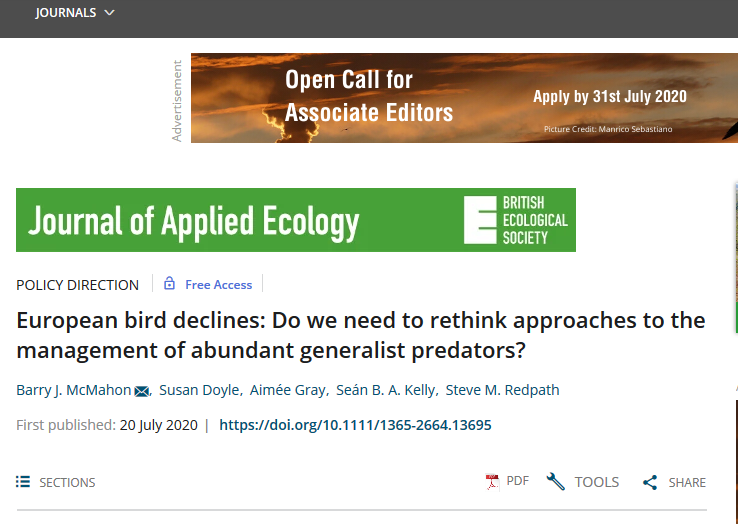
This paper is interesting but it draws an odd policy conclusion in the abstract even though not in the discussion.
It suggests that high levels of generalist predators may be a problem for ground-nesting birds in particular (not earth-shattering) but then in the abstract says ‘If we value our ground‐nesting bird species, consideration needs to be given to the control of widespread generalist predators, at least until landscapes are restored.‘ whereas the discussion is much more nuanced and mentions all those millions of Pheasants and the lack of large carnivores. they fail to mantion the lack of large avian predators though. Fewer Pheasants being released and more Goshawks flying around would lead to fewer Carrion Crows, and more Golden Eagles and White-tailed Eagles would have an impact on both avian and mammalian predators.
Interesting paper though. I do wish that scientific journals were better at refereeing the policy bits of papers as well as the science.
[registration_form]
Thanks for linking to that paper Mark; very interesting. I must say that on my reading the abstract does reflect the full discussion – “consideration needs to be given…” is about as mild as you could get. And they do refer to “the disappearance of apex predators” which I interpreted as including avian ones.
If we are going to save the curlew, to give one example, then it’s very likely that control of abundant generalist predators is going to be one tool that needs to be deployed. Fortunately the RSPB are urgently researching this, which is just what the paper is calling for. That this research is opposed in some quarters is regrettable.
‘I do wish that scientific journals were better at refereeing the policy bits of papers as well as the science’.
I am no expert by any means but when i read the famous Potts paper on Hen Harriers it all made sense until some of the sweeping statements in the conclusion which were based on nothing more than sweeping statements in other papers.
https://www.gwct.org.uk/research/scientific-publications/1990-99/1998/potts1998/
It seems to be increasingly common to slide propaganda statements into the abstracts and conclusions sections of papers. I agree with Mark – these sections should be refereed more critically, particularly since they may be the only parts read by many people.
Another common trick is to elide between breeding success and population changes when considering the effects of predation.
I really don’t like this study. The results say absolutely nothing about predation – the only variables tested are ground nesting (or not), Annexe I designation (or not) and association with agricultural habitats. Given this, I am amazed the journal allowed the phrase ‘abundant generalist predators’ to appear in the title. I also found it difficult to work out the indices of abundance (breeding population for Europe, distribution change for Britain?), or the time periods considered (post-1988 for Britain (?) – when many of the severe declines occurred before that).
Finally, I’m always struck that some of the species in real trouble here (Tree Sparrow, Willow Tit, Turtle Dove) are not ground-nesters.
Overall, not my favourite paper.
There’s an easy way through the problem – restore the landscapes immediately. The barriers are almost entirely institutional and despite the continuous wailing for more money from the conservation sector, if you look at the Natural Capital Committe reccomendations you’ll find that much of what needs to be done can be done within existing spend – and, in some cases such as flooding, there is noth a lot of money to be saved and also the loomimg resilience issues around extreme weather events.